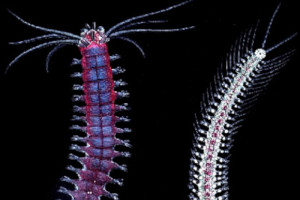Generalities
Trochozoans are a large phylogenetic group that also includes molluscs and plathelminths. They are the third major branch of the bilaterians, along with the deuterostomians (including vertebrates or echinoderms) and ecdysozoans (including arthropods or nematodes). Annelids belong to the trochozoa family. They show anatomical and developmental features that are thought to be already present in the Urbilaterian, the last common ancestor of the bilaterians. The ease of laboratory rearing of the marine annelid Platynereis dumerilii (P. dumerilii) allows the study of all aspects of its life cycle. As of today, the first investigations of the P. dumerilii genome show, contrary to what was previously thought, that annelids are genetically closer to humans than are insects or nematodes.
Reproduction
Eggs develop in a thick layer of jelly and drift in the water. After about 18 hours of development, the eggs emerge from their shells as larvae called trochophores. The trochophores develop into young worms composed of three segments and a terminal pole bearing the anus, named pygidium.
Young worms have a rounded head and three pairs of legs, and are constantly moving. They feed for about ten days. New segments proliferate from a sub-terminal area of the posterior pole.
After a life span of four to twelve months in the laboratory, the worms become sexually mature. Individuals then undergo metamorphosis: females appear yellow and males have a white anterior side and a red posterior side. Sexually mature individuals perform a courtship dance and die quickly after fertilization. It should be noted that in the laboratory, it is possible to obtain individuals at several stages of development by controlling the photoperiod.
Tools
- Cloning of a large number of genes, determination of their expression profiles by in situ hybridization, possibility of fluorescent in situ hybridizations and therefore also duplicates.
- Possible immunostaining (when antibodies are available: for the moment few specific antibodies against P. dumerilii proteins are available). Stage 1 cell embryos are injectable: first conclusive results of injection of morpholinos to make knock-down of specific genes. Trials in progress for RNA interference techniques.
- First promising transgenesis trials: a first transgenic line is being established in the laboratory of K. Tessmar-Raible in Vienna (the regulatory region of a tubulin gene has been combined with the coding region of the GFP, all introduced into the genome by means of a minos transposon).
- A series of chemical molecules that interfere with signaling pathways have been tested and found to work. This allowed interference with Hedgehog, BMP2/4, FGF, EGF, Notch and JAK/STAT channels.
- BAC libraries allowing a very good coverage of the available genome. 8.5 MB of genomic DNA have been sequenced by the Genoscope corresponding to the sequencing of several clones of a BAC library.
- Possibility of fluorescent in situ hybridization (FISH) on chromosomes to locate genes.
-
A large number of EST available: 40000 ESTs produced by the genoscope and 20000 ESTs produced by MPI Berlin (sequencing of about 1 Kb in 5' and 1 Kb in 3' of cDNAs from a 48 hpf cDNA larval library).
By the end of the year, an additional 2.4 million ESTs produced at the genoscope by sequencing by the 454 FLX technique, cDNA from 6 different life stages of the animal (larvae, growing adults, mature adults) are expected to be obtained.
Databases
Toxicology database :
http://www.pesticideinfo.org/
Infrastructures
- Laboratoire Evolution et Développement des Métazoaires de l’IJM - Guillaume Balavoine et Michel Vervoort
- http://www.univ-paris-diderot.fr/sc/site.php?bc=accueil&np=pageActu&ref=2463
- Paris
- Laboratoire de Neuroimmunologie des annélides
- http://www.univ-lille1.fr/lea/Menu_du_Site/Menu_Laboratoire.htm
- Lille
Experts
- Michel VERVOORT
- vervoort.michel@ijm.univ-paris-diderot.fr
- Equipe Evolution et développement des métazoaires, Institut Jacques Monod, Paris
Bibliography
- Articles
″Mechanism of phototaxis in marine zooplankton.″, Jékely G, Colombelli J, Hausen H, Guy K, Stelzer E, Nédélec F, Arendt D., Nature. 2008 Nov 20;456(7220):395-9.
″Complementary striped expression patterns of NK homeobox genes during segment formation in the annelid Platynereis.″, Saudemont A, Dray N, Hudry B, Le Gouar M, Vervoort M, Balavoine G., Dev Biol. 2008 May 15;317(2):430-43.
″beta-Catenin asymmetries after all animal/vegetal-oriented cell divisions in Platynereis dumerilii embryos mediate binary cell-fate specification.″, Schneider SQ, Bowerman B., Dev Cell. 2007 Jul;13(1):73-86.
″Molecular architecture of annelid nerve cord supports common origin of nervous system centralization in bilateria.″,Denes AS, Jékely G, Steinmetz PR, Raible F, Snyman H, Prud’homme B, Ferrier DE, Balavoine G, Arendt D. Cell. 2007 Apr 20;129(2):277-88.
″Vertebrate-type intron-rich genes in the marine annelid Platynereis dumerilii.″, Raible F, Tessmar-Raible K, Osoegawa K, Wincker P, Jubin C, Balavoine G, Ferrier D, Benes V, de Jong P, Weissenbach J, Bork P, Arendt D., Science. 2005 Nov 25;310(5752):1325-6.
- Websites
